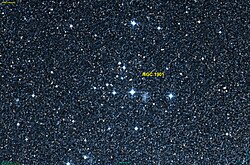NGC 1901
Appearance
| Observation data Epoch J2000 Equinox J2000 | |
|---|---|
| Constellation | Dorado |
| Right ascension | 05h 18m 11.0s[1][2] |
| Declination | −68° 27′ 00″[1][2] |
| Characteristics | |
| Astrometry | |
| Radial velocity (Rv) | -1.354 km/s |
| Distance | 1,354 ly (415 [3] pc) |
| Details | |
| Age | 0.6[4] Gyr |
| Other designations | |
ESO 56-SC91, OCL 791 | |
NGC 1901 is an open cluster in the Dorado Constellation. It has a bright middle and is a little rich, with stars from 7th magnitude downwards. The celestial object was discovered on 30 December 1836 by the British astronomer John Herschel.[5] The cluster is sparsely populated with GAIA data suggesting a membership of around 80 stars.[6] It is considered unlikely it will survive its next pass through the Milky Way’s galactic plane in about 18 million years time.[6]
References[edit]
- ^ a b "NGC 1901". Simbad.
- ^ a b "NED results for object NGC 1901". NASA/IPAC Extragalactic Database. Retrieved 24 July 2016.
- ^ "WEBDA page for open cluster NGC 1901". WEBDA. Retrieved 24 July 2016.
- ^ Pavani, D. B.; Bica, E.; Dutra, C. M.; Dottori, H.; Santiago, B. X.; Carranza, G.; Díaz, R. J. (August 2001). "Open clusters or their remnants: B and V photometry of NGC 1901 and NGC 1252". Astronomy & Astrophysics. 374 (2): 554–563. arXiv:astro-ph/0106026. Bibcode:2001A&A...374..554P. doi:10.1051/0004-6361:20010741. ISSN 0004-6361. S2CID 119447371.
- ^ "NGC 1901". Retrieved 24 July 2016.
- ^ a b Kos, Janez; de Silva, Gayandhi; Buder, Sven; Bland-Hawthorn, Joss; Sharma, Sanjib; Asplund, Martin; D’Orazi, Valentina; Duong, Ly; Freeman, Ken (2018-08-13). "The GALAH survey and Gaia DR2: (non-)existence of five sparse high-latitude open clusters". Monthly Notices of the Royal Astronomical Society. 480 (4): 5242–5259. arXiv:1807.00822. Bibcode:2018MNRAS.480.5242K. doi:10.1093/mnras/sty2171. ISSN 0035-8711.

